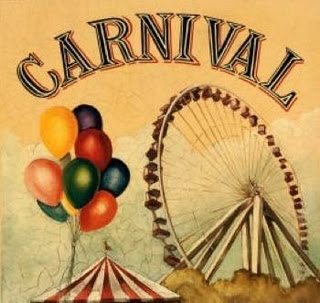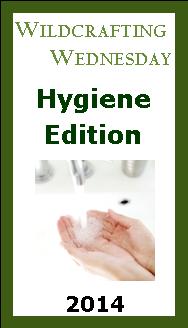But I'd like to mention a few preparations that could be included in our medicine chest that aren't herbal in nature although they are highly compatible with all the herbal remedies we've discussed. Join me as I take this herbal adventure in a slightly different direction with the same goal in mind...maintaining good health.
The Herbal Medicine Chest has it's own button! Grab it from the side bar to share on your site.

Ever experience that warm feeling of smoke in a tender ear during a cold? Often, it's just enough to ease the pain for a few minutes. Ear candling has always fascinated me but I've never been brave enough to try it. My daughter was also interested in trying it but as with most things, when I get an idea in my head, I don't want to wait until an order comes to move ahead. We had muslin and beeswax on hand so we decided to make our own ear candles!
 So for all you DIY mamas out there, here's how we did it and what we learned:
So for all you DIY mamas out there, here's how we did it and what we learned:
 So for all you DIY mamas out there, here's how we did it and what we learned:
So for all you DIY mamas out there, here's how we did it and what we learned: We started with strips of muslin approx 2" wide by 12"-14" long. Melting the beeswax in a double boiler seemed the best way to go about it because we could easily move the pot and all to the work area from the stove without losing heat too quickly. We added a little eucalyptus EO to the wax for the benefits of aromatherapy during the process. After oiling a 1/2" wooden dowel with olive oil, we dipped a strip of cloth in the hot wax and began wrapping it around the dowel. It was a little hard to form a nice cone at the end so after a few tries, we started forming the come with the fabric and then dipping that part in the wax. After it had cooled a bit, we put it over the end of the dowel and started the wrapping from there. Each cone turned out to be about 10"-12" long.
We started with strips of muslin approx 2" wide by 12"-14" long. Melting the beeswax in a double boiler seemed the best way to go about it because we could easily move the pot and all to the work area from the stove without losing heat too quickly. We added a little eucalyptus EO to the wax for the benefits of aromatherapy during the process. After oiling a 1/2" wooden dowel with olive oil, we dipped a strip of cloth in the hot wax and began wrapping it around the dowel. It was a little hard to form a nice cone at the end so after a few tries, we started forming the come with the fabric and then dipping that part in the wax. After it had cooled a bit, we put it over the end of the dowel and started the wrapping from there. Each cone turned out to be about 10"-12" long.
When the wax had cooled a few minutes, we gently twisted the dowel while holding the candle in the other hand to loosen it. Voila! Ear candles!
After trying them out, we realized that there was a potential for wax to drip inside the candle and possibly into the ear. Some of the sites online had filters in their candles so we tried pushing a small piece of cotton ball down inside the candle to about 3" from the cone where you would normally stop burning. The problem with this was that wax melting down the inside of the tube onto the cotton sometimes covered the top completely blocking the flow of air and making the candling ineffective. Another option would be to wrap the fabric onto the dowel and then dip it in wax so that any melting wax would be on the outside.
Candling is a two person job because of the safety factors involved with trimming the candle and the flame itself. Please don't try to do it alone.
Candling is a two person job because of the safety factors involved with trimming the candle and the flame itself. Please don't try to do it alone.
 Before you begin, gently examine the ear for any irritation or redness. While candling is used to heal or soothe certain ear issues, use caution where infection or ear drum pressure may be higher than normal. To use the candle, we made a hole in a foam plate covered with foil just big enough to put the candle through. The "candlee" should be lying comfortably on their side with the ear to be candled up...of course. Some sites show the person sitting in a chair but we found that lying down was more relaxing and easier for the person assisting to maintain the candle. If you are having trouble with one ear, candle the opposite side first according to all instructions I've read. After covering the person's head and shoulders to avoid any wax dripping should they move while the candle is burning, we lit the end. The flame was surprisingly high. To avoid ash or hot pieces from dropping into the candle or the ear, we cut the burnt end off at about 1" intervals into a glass or bowl with some water in it. It took about 10 minutes for the candle to burn down to the 3" mark. The candle was gently snuffed out and removed from the ear. The ear seemed clean. Then we did the other side.
Before you begin, gently examine the ear for any irritation or redness. While candling is used to heal or soothe certain ear issues, use caution where infection or ear drum pressure may be higher than normal. To use the candle, we made a hole in a foam plate covered with foil just big enough to put the candle through. The "candlee" should be lying comfortably on their side with the ear to be candled up...of course. Some sites show the person sitting in a chair but we found that lying down was more relaxing and easier for the person assisting to maintain the candle. If you are having trouble with one ear, candle the opposite side first according to all instructions I've read. After covering the person's head and shoulders to avoid any wax dripping should they move while the candle is burning, we lit the end. The flame was surprisingly high. To avoid ash or hot pieces from dropping into the candle or the ear, we cut the burnt end off at about 1" intervals into a glass or bowl with some water in it. It took about 10 minutes for the candle to burn down to the 3" mark. The candle was gently snuffed out and removed from the ear. The ear seemed clean. Then we did the other side.
After both were finished, we decided to cut the candles open to see what was inside. What we found was some waxy residue and a light powdery ash. Many sites claim that ear candles create a vacuum inside the ear drawing out pieces of wax and pollen, etc. from the ear canal. Being a little skeptical, we checked it out by burning a candle in a clean jar. The residue was exactly the same as the ones used in our ears.
However, my daughter has one ear that produces more wax and she sometimes has trouble with it. After candling that ear we looked in the ear itself and found that wax had moved much closer to the opening after candling and could be removed more easily. The idea of a vacuum makes sense but the power of that vacuum is what we're not sure about. Loose pollen or dirt may be drawn out by the chimney type suction created by the flame but I think this would only work if the person is lying down.
However, my daughter has one ear that produces more wax and she sometimes has trouble with it. After candling that ear we looked in the ear itself and found that wax had moved much closer to the opening after candling and could be removed more easily. The idea of a vacuum makes sense but the power of that vacuum is what we're not sure about. Loose pollen or dirt may be drawn out by the chimney type suction created by the flame but I think this would only work if the person is lying down.
Swimmer's ear is another problem that can be helped by ear candling. Some people feel that ear candling can improve your sense of taste and smell as well as allow you to think more clearly. TMJ sufferers have found that candling can ease jaw pain. It make sense that headaches could also be relieved. There are probably more benefits to learn about. Faithful ear candling has been practiced by lots of people over centuries past so at least some folks must find relief of some kind. I've helped with the candling for everyone in my family...now I need someone to do it for me!
As with any alternative treatment, use caution and be educated about the process. If you have had a recent ear surgery or ear drum rupture, do not use ear candles. Also if you have had tubes, or inner ear surgery candling at any time should probably be avoided until you check with you doctor. As with most alternative treatments, your doctor may not be familiar or be contemptuous of treatments outside the pharmaceutical realm.
As with any alternative treatment, use caution and be educated about the process. If you have had a recent ear surgery or ear drum rupture, do not use ear candles. Also if you have had tubes, or inner ear surgery candling at any time should probably be avoided until you check with you doctor. As with most alternative treatments, your doctor may not be familiar or be contemptuous of treatments outside the pharmaceutical realm.











